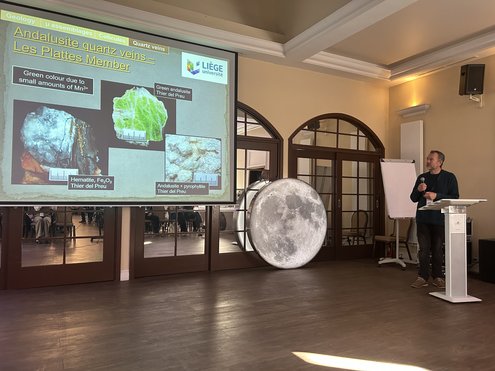The 9th Meeting of the Mineralogical Society of Poland (PTMin) and 28th Meeting of the Petrology Group of the PTMin (https://ptmin2023.ing.pan.pl/home.html) was chaired by Jakub Ciążela and his team (Weronika Patalas, Maciej Fitt, Marta Ciążela, Wojciech Woźniak, Eman Elsherif) from the Wrocław Research Centre of the ING PAN in cooperation with Warsaw (vice-chair Łukasz Kruszewski) and Kraków research centers (Marek Szczerba, Maciej Jaranowski, Fabian Tramm), as well as Adam Mickiewicz University in Poznań (vice-chair Wojciech Stawikowski), Polish Geological Institute - National Research Institute (Agata Kozłowska-Roman, Michał Tomczak), and Wrocław University (Piotr Wojtulek).
The conference was held in Hotel Dębowy Biowellness & SPA (hoteldebowy.pl), in the picturesque park and palace complex in Bielawa near Wrocław, the town between different units of the Central Sudetic Ophiolite. For the first time in many years, the conference gathered more than 100 participants, including numerous international researchers from Italy, Germany, Great Britain, South Africa, Spain, Belgium, and Hungary.
 |  |
The conference, with this year's topic "Oceanic lithosphere: rocks, minerals, and critical resources", focused on the oceanic lithosphere and ophiolites. It included eight thematic sessions. The first four of them, dedicated to the oceanic lithosphere and its vital resources, ophiolites (two sessions), and subduction zones, were held during the first conference day on Friday.
We had the pleasure of hosting prominent, worldwide-renowned Keynote Speakers. Francisco Javier González Sanz (Geological Survey of Spain / Instituto Geólogico y Minero de España, in cooperation with the GEOMAR team) got us acquainted with the challenges of deep-sea mining of manganese-rich critical-element-bearing deposits. Jürgen Koepke of the Gottfried Wilhelm Leibniz Universität Hannover in Germany discussed fast-spreading-type ophiolites in the context of the Oman Drilling Project of the International Continental Scientific Drilling Program, where he takes one of the leading roles. Ricardo Tribuzio of the Department of Earth and Environmental Sciences, University of Pavia (Italy) discussed the origin and tectonic position of ophiolites in the Alpine-Apennine complex.
The topic of the oceanic lithosphere was further exploited during the field trip on Sunday, which allowed the participants to see the exposures of rocks representing various parts of the Central Sudetic Ophiolite, including the upper mantle and the Moho transition zone at the Tąpadła Pass, gabbro, diabase dikes and basalts at Góra Kunowska, and metamorphosed oceanic sediments with metamanganolites representing former Fe-Mn crusts of the ocean floor in the Kamionki Hill near Pustków Wilczkowski.
During the Saturday ore geology session, Frédéric Hatert of the Laboratory of Mineralogy, University of Liège (Belgium) explained how to link the Fe-Mn-rich crusts with metamanganolite rocks such as present, for example, in Pustków Wilczkowski or the famous manganese coticules of the Stavelot massif, Belgium. Besides ore geology, Saturday's second set of sessions included Environmental geology, Mineralogy and petrology, and Planetary geology. In his keynote talk, Krzysztof Woźniak of the Chemistry Department, University of Warsaw, invited us into the fascinating world of high-pressure quantum crystallography of minerals. Stephen Mojzsis (Research Centre for Astronomy and Earth Sciences, MTA Centre for Excellence, Budapest / Hungarian Academy of Sciences, Hungary), in his electrifying talk, took us to extraterrestrial environments, including those beyond the Solar System, which is particularly timely, when the need of human space expansion is inevitable.
 |  |
The conference was an excellent opportunity to present the cutting-edge research currently performed at the ING PAN. The researchers of the ING PAN opened the conference (Jakub Ciążela), led 3 of 8 sessions (Łukasz Kruszewski, Marek Szczerba, Jakub Ciążela) and the field trip (Jakub Ciążela and Łukasz Kruszewski), gave seven oral presentations (Jakub Ciążela (x2), Łukasz Kruszewski, Bartosz Budzyń, Maciej Fitt, Weronika Patalas, Marek Szczerba), presented six posters (Magdalena Goryl, Eman Elsherif, Wojciech Woźniak, Fabian Tramm, Maciej Jaranowski, Marta Ciążela), and contributed to more than a dozen of other presentations presented by other researchers.
These contributions mainly focused on marine geology, ore geology, and planetary geology, covering, among the others, the most critical programs related to the Polish sulfide exploration contract area of the International Seabed Authority on the Mid-Atlantic Ridge (2018-2033) and the Polish Lunar Mission of the Polish Space Agency (2028-2032) with the MIRORES spectrometer developed at the ING PAN. In addition, Maciej Fitt obtained the award of Rysza Kryza for the best student talk from Bureau Veritas (5000 PLN grant for research) and the Petrology Section of the PTMin Society.
At the open PTMin meeting at the end of the conference, Jakub Ciążela was re-elected as a board member of the Petrology Section of the PTMin for the next term (2023-2025). Abstracts of the presentations and a description of the field trip are included in the Mineralogy Special Papers vol. 51, available in paper and electronic versions on the conference website (https://ptmin2023.ing.pan.pl/files/ptmin2023/img/doc/PTMin2023_Abstract-Book.pdf ).
 |  |

